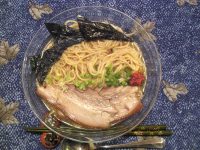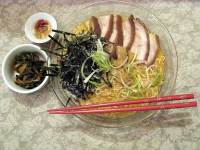In the next few posts, I will talk about how to prepare some of the most popular toppings for ramen. The list below illustrates some of the variety.
Chashu is made by simmering pork belly with garlic, ginger, sake and shoyu. Char-siu, Chinese barbecued pork, became Japanese simmered pork: chashu. Like ramen itself, it originated in China but evolved into a favorite Japanese recipe. Details about how I made chashu follow this list.
Menma is prepared by simmering dried bamboo shoots in the broth from making chashu. The broth is sweetened with mirin.
Ninniku-dare , garlic paste, is a condiment often served with ramen. It’s made by blending pork fat and garlic in a food processor then heating it to cook a golden color.
Toban jiang, Japanese chile-bean sauce, is another common condiment. You can purchase this in many Asian grocery stores.
Nori can be cut into triangles or narrow strips.
Negi, Japanese long green onion, is often cut into thin rings. Green onions are nice, too.
Eggs are often hard-boiled and sliced. Tiny quail eggs might be served whole. Sometimes the eggs are cooked as a thin omelette then julienned. Occasionally the eggs are served onsen-style.
Naruto is a fish cake with a pink spiral that becomes visible when it’s sliced thinly.
Seafood and fish are added to ramen in some regions of Japan where they are at their best.
Bean sprouts can be stir-fried or blanched to add to a bowl of ramen.
Cabbage can be chopped or shredded and stir-fried.
Corn is a real surprise to me. Butter is often added with the corn.
Kimchee can be served as a topping or as a side dish.
Plain rice, stir-fried rice, or curry rice may be served as side dishes with ramen. And often, people like to have gyoza to accompany bowls of ramen.
Chashu is made with pork flank, which is also called pork belly or side pork. This cut is often used to make bacon in the U.S. I purchased one piece from the meat department of my regular grocery store; it had thin layers of meat with thick bands of fat. I bought another piece from the freezer of an Asian grocery; it had more meat to fat ratio and has the ends of the rib(?) bones. Chashu can be frozen for later use so I’ve doubled the recipe here. The two cuts tasted and looked similar when cooked.
Simmered Pork for Ramen
Chashu
 page 336
page 336
- 3 pounds pork flank
- 8 garlic cloves, peeled and cut in half
- 2 ounces ginger, about the size of 2 ping-pong balls
- 1/2 Tablespoon salt
- 1/4 cup sake
- 1 1/4 cups soy sauce
Ms. Shimbo directs the cook to cut the pork across the grain into several 6″ blocks, but because of the bones in one piece of pork (which I left on to cook), I did not cut that piece. Some recipes I’ve seen online have the cook tie the pork into a compact round. That would make it easier to slice.
Put the pork into a large shallow pot. The pot should be large enough to fit the pieces without overlapping. Cover with water. Add garlic, ginger, salt, sake, and shoyu. Bring the mixture to a boil, and skim the foam. Reduce the heat to medium-low, cover with a drop lid and simmer gently for 40 minutes. I actually simmered the meat for an hour: my simmer was too gentle.
Remove the pork from the heat, and let the pork stand in its cooking liquid for 15 minutes.
Remove the pork from the pot, and let the broth cool to room temperature. Reserve the broth for making menma and shoyu ramen.
The pork in its broth will keep for a week in the refrigerator, or can be frozen.
To serve the chashu, slice it thinly and put it on top of a bowl of ramen.
Recipes using Chashu:
More in this series about ramen:
Ramen Stock:

Ramen Toppings:



| ⇐ Previous Post | Next Post ⇒ | |
| Kanitama-don: Japanese Crab Omelette with Rice | Ramen Toppings: Menma |









Pingback: Shoyu Ramen « Tess’s Japanese Kitchen
I tried this recipe (again) recently with boneless spareribs, which work are less fatty, don’t dry up, and taste great!
Adam,
Good to hear! If you’re interested you might try these ribs on my blog:
https://1tess.wordpress.com/2008/06/10/japanese-style-braised-spareribs-recipe/
They had really good flavor. (Mine had bones.)
Or this pork loin, which is a non-fatty cut of meat:
https://1tess.wordpress.com/2008/02/23/steamed-pork-with-ponzu-dressing/
been trying to figure out the difference between char siu and the chashu listen on the ramen menu. so confusing. so i just ate it.
http://www.chubbypanda.com/search/label/nikoramen
<p>Formatting Your Comment</p>
<p>The following XHTML tags are available for use:</p>
<p><a href=”” title=”” rel=”nofollow”> <abbr title=””> <acronym title=””> <b><br />
<blockquote cite=””> <cite> <code>
<pre> <del datetime=””> <em> <i> <q cite=””> <strike> <strong>
URLs are automatically converted to hyperlinks.</strong></strike></q></i></em></del></pre>
<p></code></cite></p></blockquote>
<p></b></acronym></abbr></a></p>
Pingback: Miso Ramen: a night for a fire « Tess's Japanese Kitchen
Pingback: The Japanese Earthquake’s Unexpected Impact On Pokémon | Kotaku Australia
Pingback: Momofuku and Ippudo – A tale of two Ramens « Beli Eats